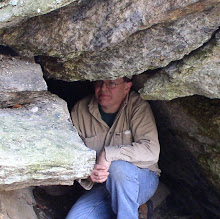One other trip I wanted to get in before the inevitable end to this year's outdoor season was a tour of a large section of karst within the central Berkshires. It is one of the more amazing pieces of geology in Massachusetts, from the speleological perspective, with a least a dozen solution formed marble caves located in a 'corridor' just over two miles long.
Taking my usual back road approach, I traveled down through the northern portions of this 'cave corridor', turning into the less inhabited woodlands, to finally come out overlooking the side of a valley. Several mountain streams drain down the sides of this valley setting up a classic cave karst scenario where waters flowing off the less soluble schists, onto marbles, eventually makes it's way underground. Not far from these 'contact zones' is often a likely site that caves might want to form. It this particular area three caves - Coon Hollow, Dolo, and Coffin Caves - are diversionary routes from the surface streams. Sometimes the surface stream beds (or sections thereof) run and sometimes can carry running water.
My first destinations were Coon Hollow and Dolo Caves where one might say they are geologically connected if not physically. They are both underground channels for the same surface stream. On this day, waters were high and normally dry sections of streambed were carrying water - right on into the cave entrances. Moving on to another section of forest, a second stream draining into the karst lands was also running water in sections not normally found and right by the entrance to Coffin Cave. Descent into the caves under these conditions would be ill advised. Somewhere within the earth the hydrological flows of the two cave systems, Coon Hollow/Dolo and Coffin, do meet and exit through a major spring - my next stop.
Waters from this spring travel a ways down through a beautiful section of wilderness and on into a geologically separate section of karst. Paralleling close to the main stream is one running underground where a small section can be accessed through Blanket Cave. Eventually a couple hundred feet farther along - much further than one can travel through the cave, the underground waters issue forth and travel somewhat alongside the main brook. Eventually a second stream coming from a slightly uphill resurgence joins the Blanket Cave stream. And even farther along the hillside a third resurgence can be located.
Some of all this 'resurged water' comes from an upland plateau of sorts - another less obvious example of karst topography. Waters coming off the shoulder of the valley highlands do eventually make their way underground upon the plateau, in the insurgence once know as Temper Hole. Beyond Temper the plateau exhibits characteristics of underground features with sunken ravines and sinkholes.Most of these features end in the area where Bill Blankey's Cave is found (whomever Bill Blankey is/was - is lost to time) preceded by newly discovered Skeleton Cave found higher on the ravine's wall.
With all caves visited and accounted for, it was only left to make my way back up and out the valley of karsts. Returning to my car I find an eager group of orange clad men pouring out of their SUV in preparation for the next day's beginning of shotgun deer hunting season. Retracing my route home by way of the woods road, I passed more streams diving into the ground providing warm memories of past excursions into the nether regions of this expansive karst.



